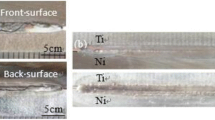Abstract
A three-layered explosion-welded (EXW) plate consisting of Ti-alloy/Ni/steel was investigated. Both the Ti/Ni and Ni/steel interfaces displayed a wavy shape typical of the EXW process, which reflects the occurrence of massive mass transfer during bonding. New phase formation was not observed at the Ni/steel interface, while, according to the SEM, XRD, and nanoindentation testing, the formation of brittle intermetallic phases took place at the Ti-alloy/Ni interface. These intermetallics serve as the weakest part of the joint and determine a brittle mode of fracture under tensile stress. The tensile strength of the joint is about 300 MPa, which is determined by intermetallic phases formed at the Ti/Ni interface.















Similar content being viewed by others
References
B. Crossland, Explosive Welding of Metals and Its Application. Oxford Series on Advanced Manufacturing, illustrated edn. (Clarendon Press, Oxford, 1982), pp. 1–39
O.R. Bergeman, G.R. Cowan, A.H. Holtzman, Experimental evidence of jet formation during explosive cladding. Trans. Soc. Min. Eng. AIME 236, 646–653 (1966)
F.A. McKee, B. Crossland, Further experiments on the mechanism of explosive welding, in Proceedings of the 5th International Conference of High Energy Rate Fabrication, June 24–26, Denver University, Denver, CO, 1975, pp. 1–25
K. Raghukandan, Analysis of the explosive cladding of Cu-low carbon steel plates. J. Mater. Process. Technol. 139, 573–577 (2003)
K. Raghukandan, K. Hokamoto, P. Manikandan, Optimization of process parameters in explosive cladding of mild steel and aluminum. Met. Mater. Int. 10(2), 193–197 (2004)
Y. Morizono, M. Nishida, A. Chiba, Diffusion barrier effect of carbide layer on bonding characteristics of Ti/steel clad. Mater. Res. Soc. Symp. Proc. 458, 363–368 (1997)
P. Manikandan, K. Hokamoto, A.A. Deribas, K. Raghukandan, R. Tomoshige, Explosive welding of titanium/stainless steel by controlling energetic conditions. Mater. Trans. JIM 47(8), 2049–2055 (2006)
A. Nobili, J.G. Banker, in Proceedings of Reactive Metals in Corrosive Applications Conference, September, Wah Chang, Albany, OR, 1999, pp. 83–88
F. Findik, Recent developments in explosive welding. Mater. Des. 32(3), 1081–1093 (2011)
H. Paul, M. Faryna, M. Prażmowski, R. Bański, Changes in the bonding zone of explosively welded sheets. Arch. Metall. Mater. 56(2), 463–474 (2011)
V.I. Lysak, S.V. Kuzmin, Lower boundary in metal explosive welding. Evolution of ideas. J. Mater. Process. Technol. 212(1), 150–156 (2012)
S. Kundu, S. Chatterjee, Characterization of diffusion bonded joint between titanium and 304 stainless steel using a Ni interlayer. Mater. Charact. 59(5), 631–637 (2008)
G.F. Bastin, G.D. Rieck, Diffusion in the titanium–nickel system: I. Occurrence and growth of the various intermetallic compounds. Metall. Mater. Trans. 5(8), 1817–1826 (1974)
N. Kahraman, B. Gülenç, F. Findik, Joining of titanium/stainless steel by explosive welding and effect on interface. J. Mater. Process. Technol. 169(2), 127–133 (2005)
ASM Handbook, Properties & Selection—Nonferrous Alloys & Special-Purpose Materials, vol. 2, 10th edn. (ASM International, Novelty, 1992), pp. 431–435, 592–633
J. Song, A. Kostka, M. Veehmayer, D. Raabe, Hierarchical microstructure of explosive joints: example of titanium to steel cladding. J. Mater. Sci. Eng. A 528(6), 2641–2647 (2011)
Metals Handbook, Properties and Selection: Irons, Steels, and High-Performance Alloys, vol. 1, 10th edn. (ASM International, Novelty, 1990), pp. 195–199
ASM Ready Reference, Thermal Properties of Metals, First Printing (ASM International, Novelty, 2002), pp. 28–29, 184–185
W.C. Oliver, G.M. Pharr, An improved technique for determining hardness and elastic modulus using load and displacement sensing indentation experiments. J. Mater. Res. 7(6), 1564–1583 (1992)
Acknowledgments
Special thanks to ATI-Allegheny Technologies Inc. for supplying the materials which permitted the research. The authors would also like to thank Zvia Shmul from Soreq Nuclear Center for her assistance with SAM, Hagit Didi from Ben Gurion University for her contribution to SEM operation, Dr. Sidney Cohen from the Weizmann Institute for his help with Nanoindentation, and Dr. Zehava Barkay from the Wolfson Applied Materials Research Center for her help with ESEM operation.
Author information
Authors and Affiliations
Corresponding author
Rights and permissions
About this article
Cite this article
Rosenthal, I., Miriyev, A., Tuval, E. et al. Characterization of Explosion-Bonded Ti-Alloy/Steel Plate with Ni Interlayer. Metallogr. Microstruct. Anal. 3, 97–103 (2014). https://doi.org/10.1007/s13632-014-0120-1
Received:
Revised:
Accepted:
Published:
Issue Date:
DOI: https://doi.org/10.1007/s13632-014-0120-1




